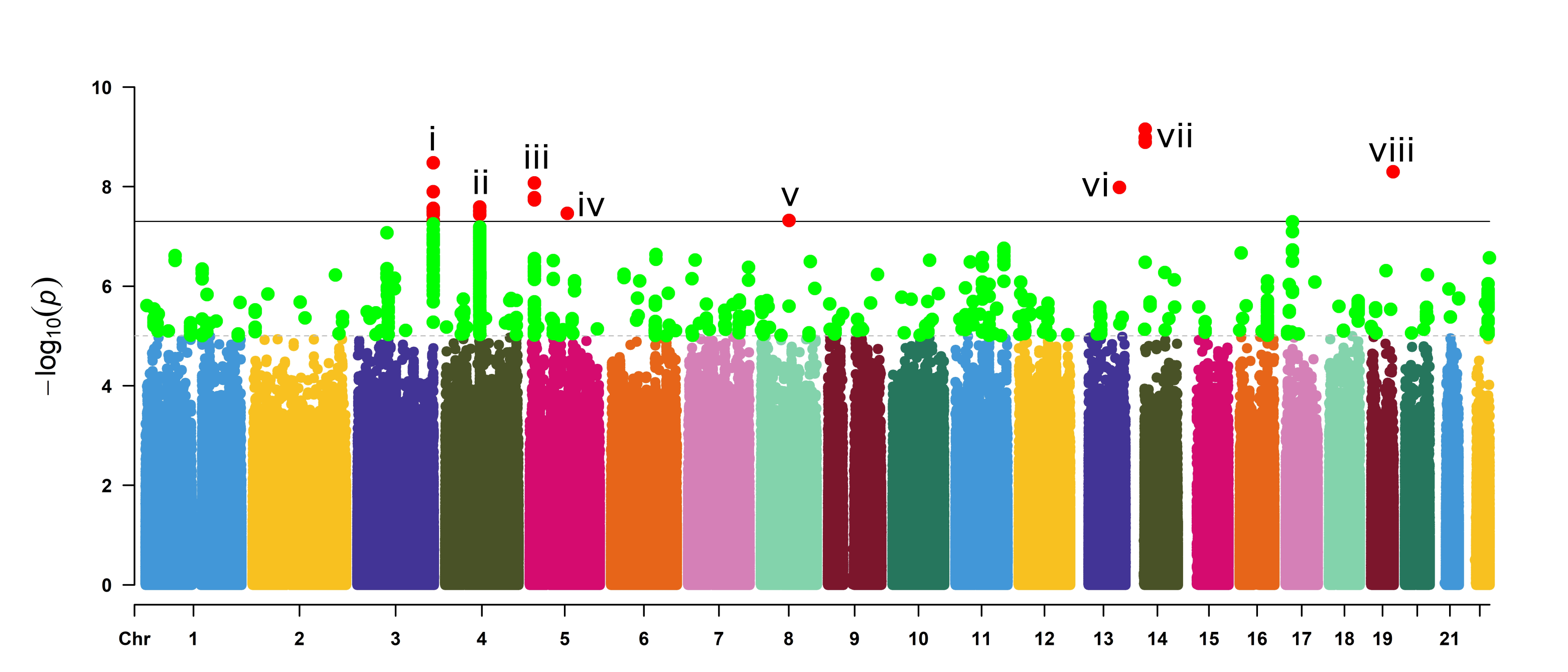Category: Parkinson's Disease: Genetics
Objective: Our objective was using TRACTOR[1], which performs Genome Wide Association Study (GWAS) including Local Ancestry (LA) information, in Parkinson Disease (PD) using data from the Latin American Research consortium on the GEnetics of PD (LARGE-PD). LA is the inference of genetic ancestry of a particular chromosomal region for an individual.
Background: GWAS have identified more than 90 PD associated risk variants, but these studies were performed, for the most part, in European and Asian populations, leading to a limited understanding of the genetic component in other populations. We performed the first PD GWAS[2] in a Latin American cohort, but the methods employed did not use LA, which could lead to a loss of statistical power due to genetic heterogeneity.
Method: We included 1,498 individuals from Brazil, Chile, Colombia, Peru, and Uruguay genotyped using Multi-Ethnic Genotyping Array from LARGE-PD[2]. We performed genetic quality control (QC), inferred the relatedness between the individuals and those at greater than second degree were removed. We inferred the LA in the samples using RFMix and African, European and Native-American samples from 1000 Genomes as reference[3]. We imputed the QC data using TOPMed imputation server and variants with quality score r² < 0.8 were removed. We performed TRACTOR using the admix-kit package[4](Figure 1).
Results: We identified eight risk loci, with six being novel: (i) rs78820950 near the NRROS gene, with suggestive p-value in our previous LARGE-PD work; (ii) rs356183 inside the SNCA gene; (iii) rs1112917, near a variant associated to smoking initiation[5]; (iv) rs291799 near the RIOK2 gene; (v) rs7014367 inside SBSPON gene; (vi) rs7983023 is near SLC15A1 gene, that encodes proteins that transport amino acid in the large intestine[6]; (vii) rs72686482 inside TRAV27 gene, a T cell receptor; and (viii) rs736994 near the ZNF264 gene, that encodes a Zinc Finger Protein. Zinc is very important for neuronal signaling and the ZNF protein family is associated to neurodegenerative diseases and early onset PD in Chinese Population[7-9]
Conclusion: The inclusion of LA boosted the results from our previous GWAS, reinforcing the association with the SNCA and NRROS genes, and allowed us find new loci associated with PD. These results highlight the importance to properly account for evolutionary forces when dealing with admixed populations such as Latin Americans.
References: [1] Atkinson, Elizabeth G et al. “Tractor uses local ancestry to enable the inclusion of admixed individuals in GWAS and to boost power.” Nature genetics vol. 53,2 (2021): 195-204. doi:10.1038/s41588-020-00766-y
[2] Loesch, Douglas P et al. “Characterizing the Genetic Architecture of Parkinson’s Disease in Latinos.” Annals of neurology vol. 90,3 (2021): 353-365. doi:10.1002/ana.26153
[3] Byrska-Bishop, Marta et al. “High-coverage whole-genome sequencing of the expanded 1000 Genomes Project cohort including 602 trios.” Cell vol. 185,18 (2022): 3426-3440.e19. doi:10.1016/j.cell.2022.08.004
[4] Hou, Kangcheng et al. “On powerful GWAS in admixed populations.” Nature genetics vol. 53,12 (2021): 1631-1633. doi:10.1038/s41588-021-00953-5
[5] Liu, Mengzhen et al. “Association studies of up to 1.2 million individuals yield new insights into the genetic etiology of tobacco and alcohol use.” Nature genetics vol. 51,2 (2019): 237-244. doi:10.1038/s41588-018-0307-5
[6] Wang W, Jiang S, Xu C, Tang L, Liang Y, Zhao Y, Zhu G. Interactions between gut microbiota and Parkinson’s disease: The role of microbiota-derived amino acid metabolism. Front Aging Neurosci. 2022 Nov 2;14:976316. doi: 10.3389/fnagi.2022.976316. PMID: 36408101; PMCID: PMC9667037.
[7] Li, Chun Yu et al. “Genetic Analysis of ZNF Protein Family Members for Early-Onset Parkinson’s Disease in Chinese Population.” Molecular neurobiology vol. 58,7 (2021): 3435-3442. doi:10.1007/s12035-021-02354-5
[8] Bu S, Lv Y, Liu Y, Qiao S, Wang H. Zinc Finger Proteins in Neuro-Related Diseases Progression. Front Neurosci. 2021 Nov 18;15:760567. doi: 10.3389/fnins.2021.760567. PMID: 34867169; PMCID: PMC8637543.
[9] Prakash, Atish et al. “Zinc: indications in brain disorders.” Fundamental & clinical pharmacology vol. 29,2 (2015): 131-49. doi:10.1111/fcp.12110
To cite this abstract in AMA style:
T. Leal, V. Borda, M. Gouveia, M. Inca-Martinez, E. Mason, D. Loesch, A. Horimoto, E. Sarihan, M. Cornejo-Olivas, L. Torres, P. Mazzetti, C. Cosentino, E. Sarapura-Castro, A. Rivera-Valdivia, A. Medina, E. Dieguez, V. Raggio, A. Lescano, V. Tumas, V. Borges, H. Ferraz, C. Rieder, A. Schumacher-Schuh, B. Santos-Lobato, C. Velez-Pardo, M. Jimenez-Del-Rio, F. Lopera, S. Moreno, P. Chana-Cuevas, W. Fernandez, G. Arboleda, H. Arboleda, C. Arboleda-Bustos, D. Yearout, C. Zabetian, T. Thornton, T. O'Connor, I. Mata. Genome Wide Association Studies using TRACTOR reveals new associated loci with Parkinson Disease in a Latino Cohort [abstract]. Mov Disord. 2023; 38 (suppl 1). https://www.mdsabstracts.org/abstract/genome-wide-association-studies-using-tractor-reveals-new-associated-loci-with-parkinson-disease-in-a-latino-cohort/. Accessed December 13, 2025.« Back to 2023 International Congress
MDS Abstracts - https://www.mdsabstracts.org/abstract/genome-wide-association-studies-using-tractor-reveals-new-associated-loci-with-parkinson-disease-in-a-latino-cohort/

